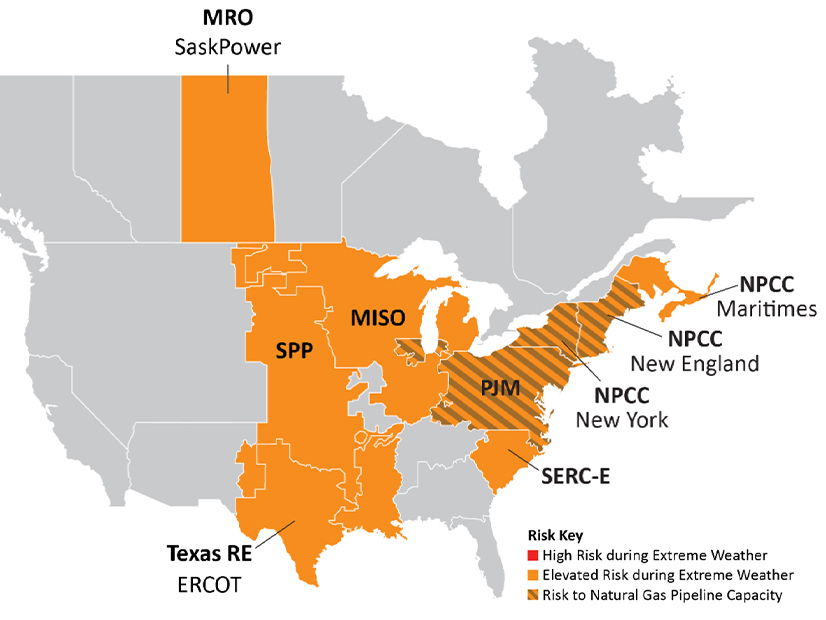
North America’s electric grid faces “familiar challenges” this winter but is also displaying “good reasons for optimism” heading into the cold months, NERC staff said while presenting the ERO’s newly release 2024-2025 Winter Reliability Assessment.
The assessment, released Nov. 14, covers December 2024 through February 2025. It was developed over “several months of work with the regional entities and industry, and reviewing projections for demand and resources and the preparations that are been put into place for this upcoming winter,” NERC Manager of Reliability Assessments Mark Olson said in a media briefing.
While the report did not identify any grid areas as facing high risk of insufficient operating reserves in normal peak conditions, it found multiple areas face elevated risk of energy shortfalls during “extreme winter conditions extending over a wide area.” All or part of most regions were mentioned as facing shortfall risks, including Texas, SPP, MISO, PJM, NPCC and SERC.
“Winter demand forecasts … are elevated across most areas that we look at,” Olson said, noting demand is projected to rise at least 2% over last winter in most assessment areas. “It’s a significant jump from last year, and that was a big jump from the year before that.”
The report also called out generation retirements in some areas as a factor in potential shortfalls. For example, MISO has experienced over 5 GW of reductions in coal and natural gas-fired generation from winter 2023/24. In MRO’s SaskPower subregion, coal generation capacity has fallen 140 MW (though offset by increases in gas generation capacity), while dispatchable thermal generation capacity “has declined by 2.6 GW from last year” in NPCC-New England and nearly 1 GW in the portion of SERC Reliability’s territory that includes North and South Carolina.
Even in areas where dispatchable generation has increased — mostly through installation of gas generation — the growth has not always kept pace with new demand. This was the case in Texas, where dispatchable resources have increased by 1 GW since last year as demand rose more than 2 GW. Although solar and wind capacity have grown by 3 GW, the report noted these resources may have limited use in times of extreme cold weather.
Limits on natural gas pipeline capacity were also noted to affect PJM, as well as NPCC’s New York and New England subregions. NERC cited “ongoing concerns with natural gas production and delivery in extreme conditions.”
Balancing these concerns, the report also observed significant action by industry and regulators to address the systemic issues revealed by the winter storms of 2021 and 2022. In the media call, Olson said “there’s a lot of information to be gained from the things that went right in the January 2024 Arctic cold blast.” FERC and NERC’s joint report, issued in April, said the grid’s performance last winter demonstrated significant progress from previous years. (See FERC, NERC Review January Winter Storm Performance.)
NERC staff also noted the ERO’s ongoing development of requirements for cold weather preparations by utilities, with EOP-012-2 (Extreme cold weather preparedness and operations) taking effect last month and its successor expected to be completed by next year. (See NERC: Board’s 321 Authority on the Table for Cold Weather Standard.)
While Olson acknowledged the challenge of quantifying the effect of the standard on grid reliability, he said the report’s authors could consider the winterization requirements’ impact on non-fuel-related generator outages. He added that utilities’ preparations ahead of the standard’s effective date could be seen in the January winter storm, which NERC took as a positive sign for the report.
‘Natural Gas Remains Essential’
In their reactions to the assessment, grid stakeholders focused on its information about energy sufficiency and resource retirements. In a press release, Todd Snitchler, CEO of the Electric Power Supply Association, said the assessment “once again underscores the serious power supply challenges facing our nation.” He added dispatchable generation resources will be key to ensuring reliability throughout the winter months.
“Natural gas remains essential to ensuring a reliable system,” Snitchler said. “Generators and our partners in the natural gas value chain have taken meaningful action to address issues faced during recent storms and to enhance gas-electric coordination. As they do every year, our member companies take significant steps to prepare for winter operations and help ensure optimal performance.”
Jim Matheson, CEO of the National Rural Electric Cooperative Association, also weighed in, emphasizing the danger that energy shortfalls pose to “the health of local communities and … the American economy.”
“Demand for electricity is skyrocketing across America, and supply is not keeping pace. And flawed public policies that focus on shutting down always available power generation are compounding this problem,” Matheson said. “This report clearly highlights the need to swiftly implement a pro-energy policy agenda with a focus on affordability and reliability for American families and businesses. Smart energy policies that keep the lights on are more important than ever.”


